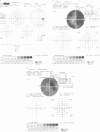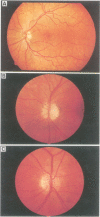Abstract
Inherited optic neuropathies are a significant cause of childhood and adult blindness and dominant optic atrophy (DOA) is the most common form of autosomally inherited (non-glaucomatous) optic neuropathy. Patients with DOA present with an insidious onset of bilateral visual loss and they characteristically have temporal optic nerve pallor, centrocaecal visual field scotoma, and a colour vision deficit, which is frequently blue-yellow. Evidence from histological and electrophysiological studies suggests that the pathology is confined to the retinal ganglion cell. A gene for dominant optic atrophy (OPA1) has been mapped to chromosome 3q28-qter, and studies are under way to refine the genetic interval in which the gene lies, to map the region physically, and hence to clone the gene. A second locus for dominant optic atrophy has recently been shown to map to chromosome 18q12.2-12.3 near the Kidd blood group locus. The cloning of genes for dominant optic atrophy will provide important insights into the pathophysiology of the retinal ganglion cell in health and disease. These insights may prove to be of great value in the understanding of other primary ganglion cell diseases, such as the mitochondrially inherited Leber's hereditary optic neuropathy and other diseases associated with ganglion cell loss, such as glaucoma.
Full text
PDF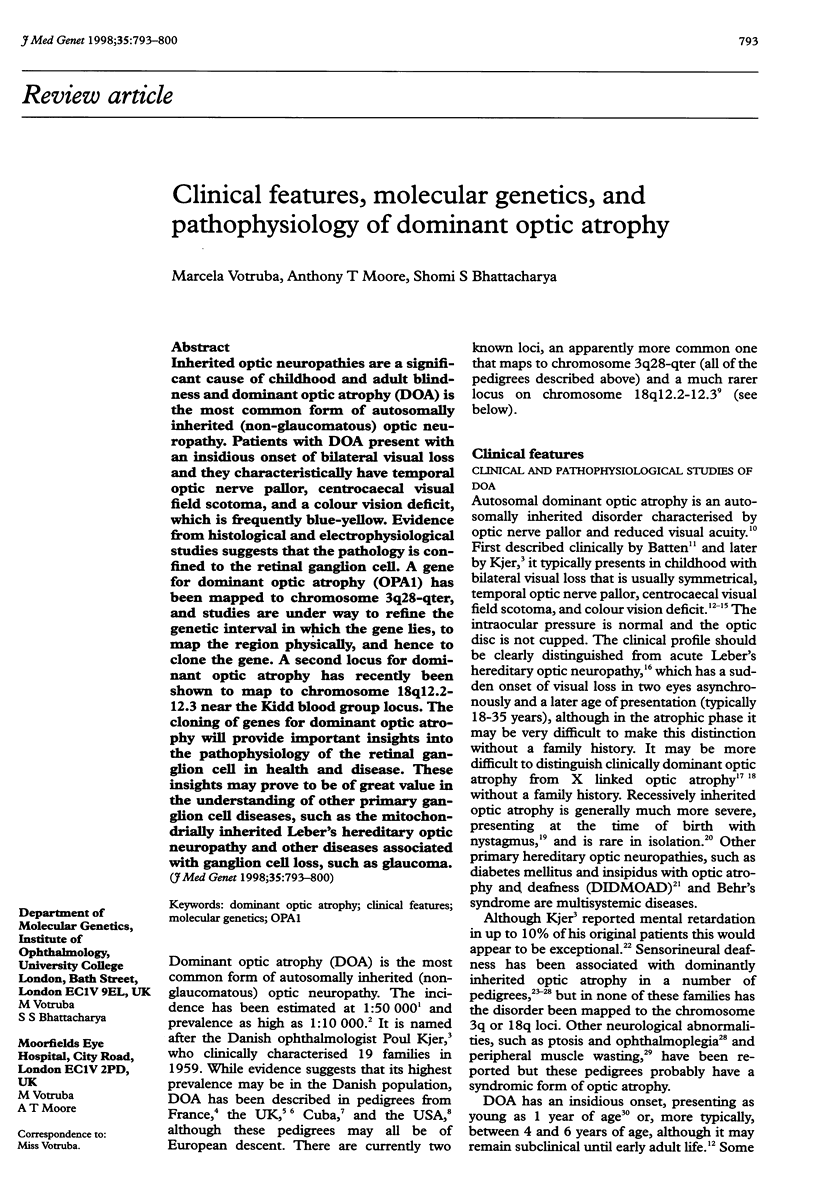
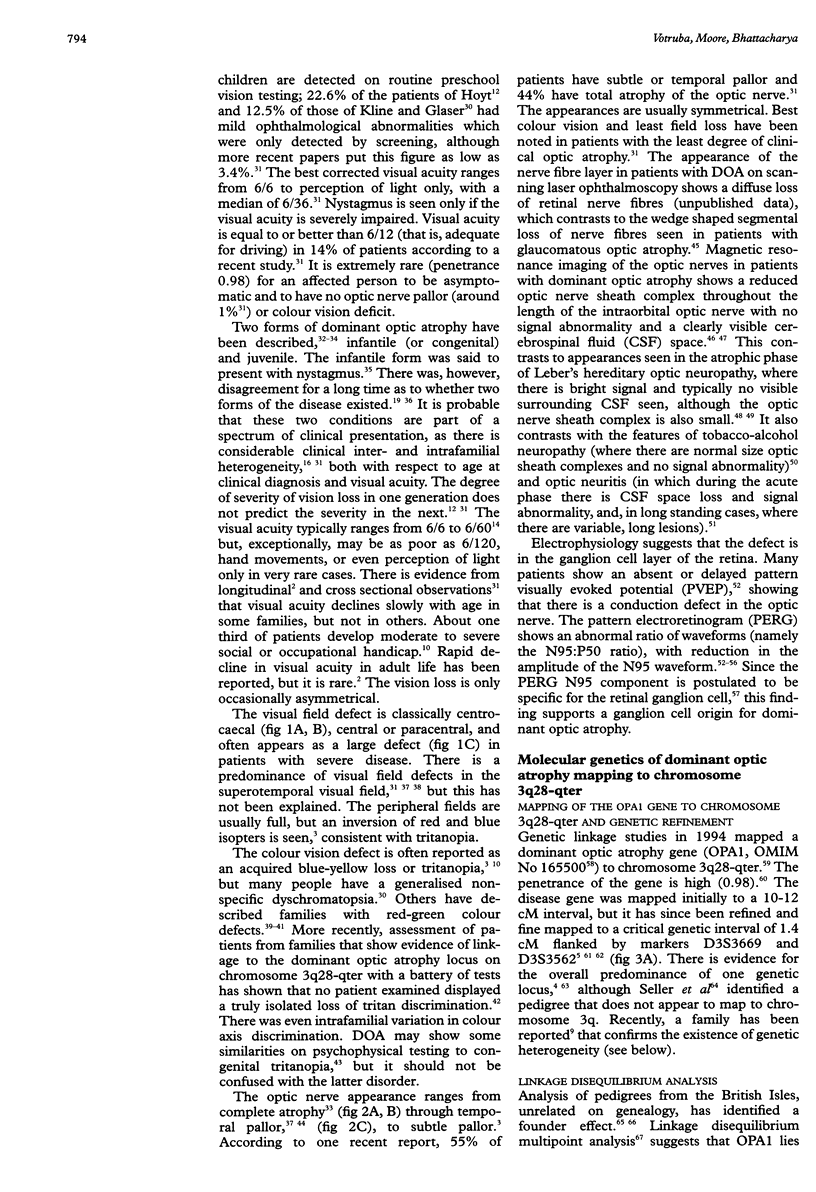
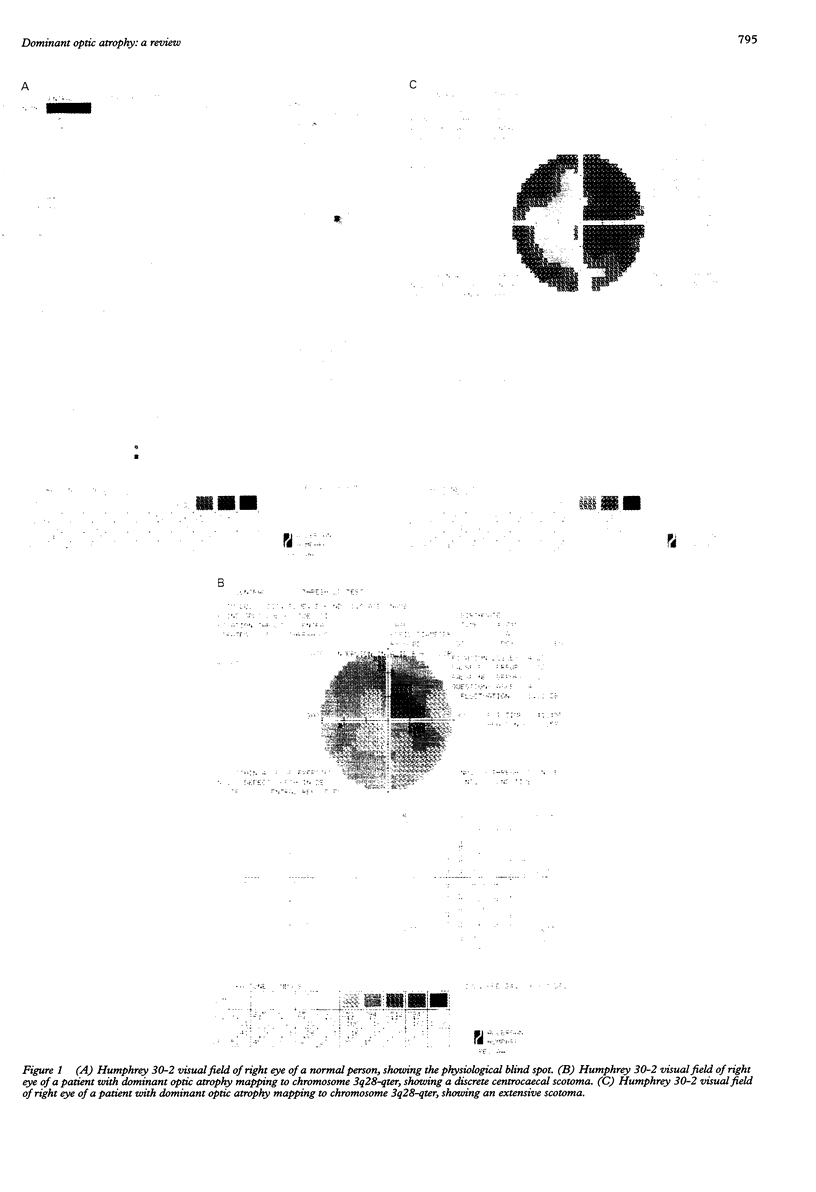
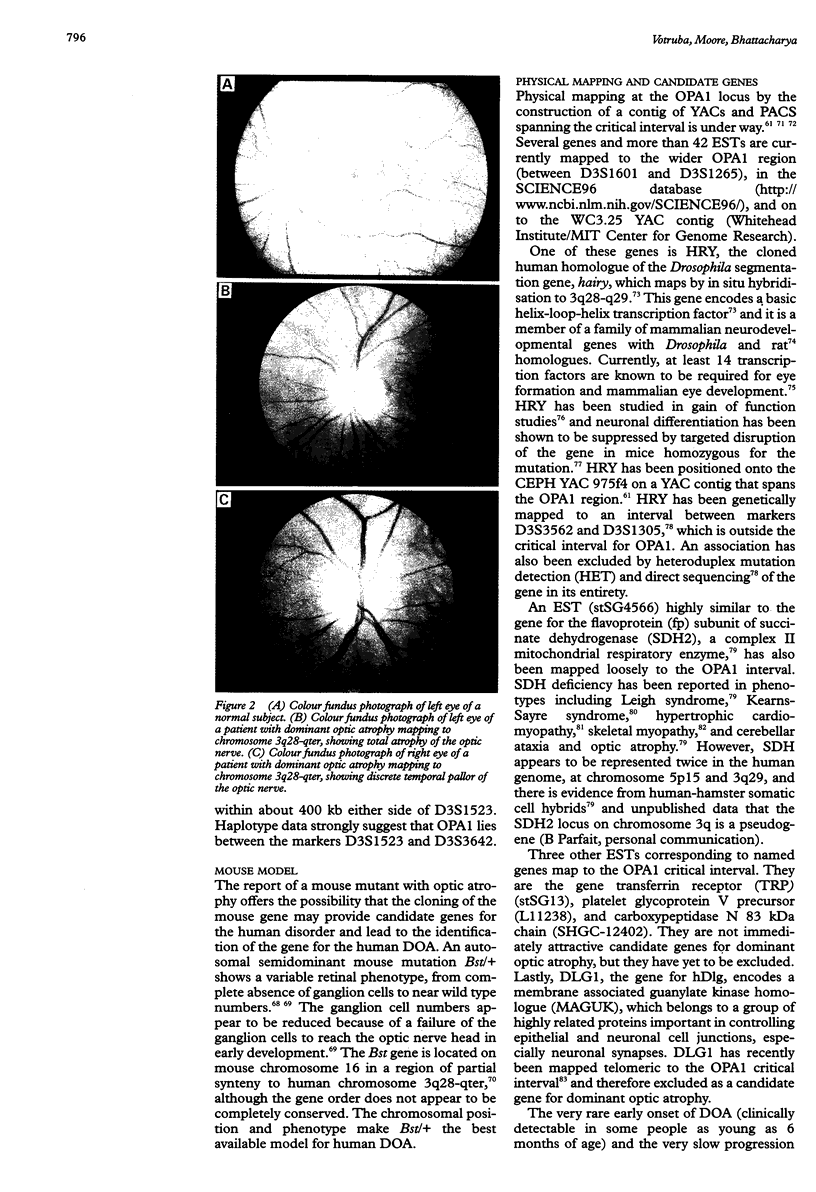
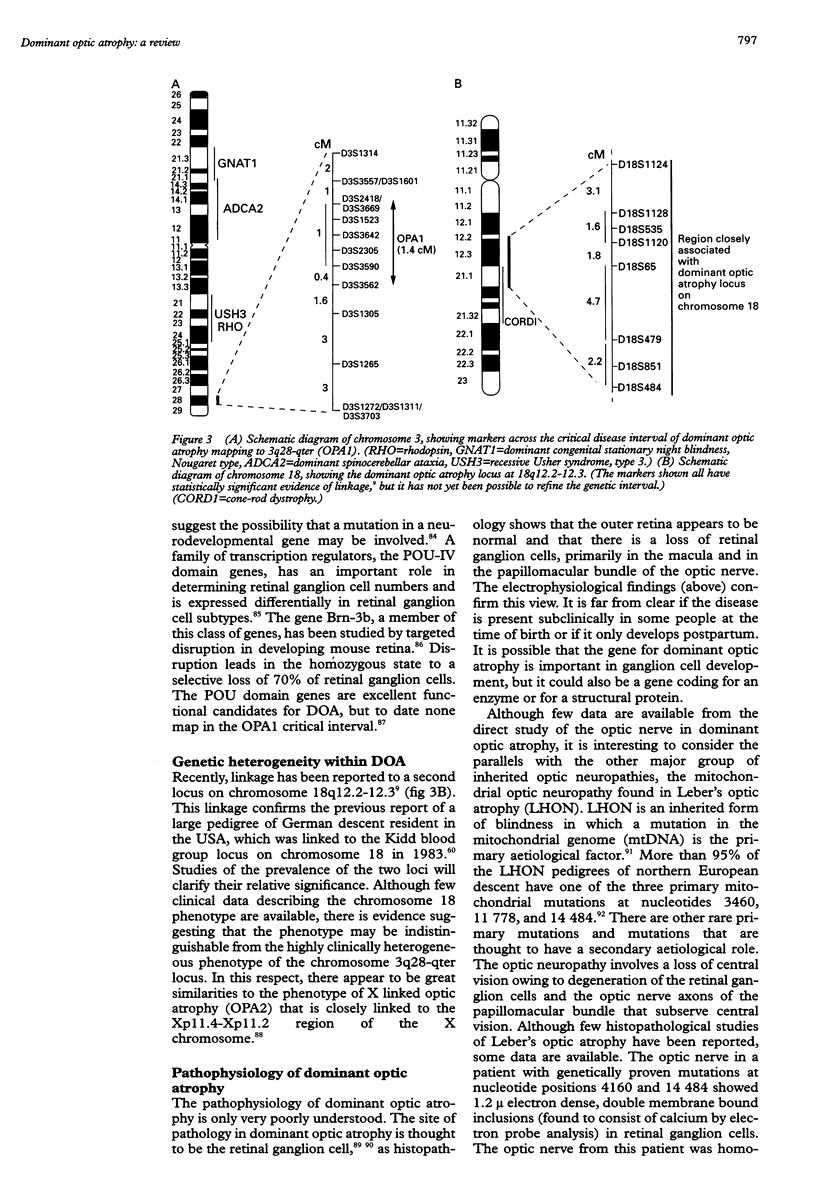
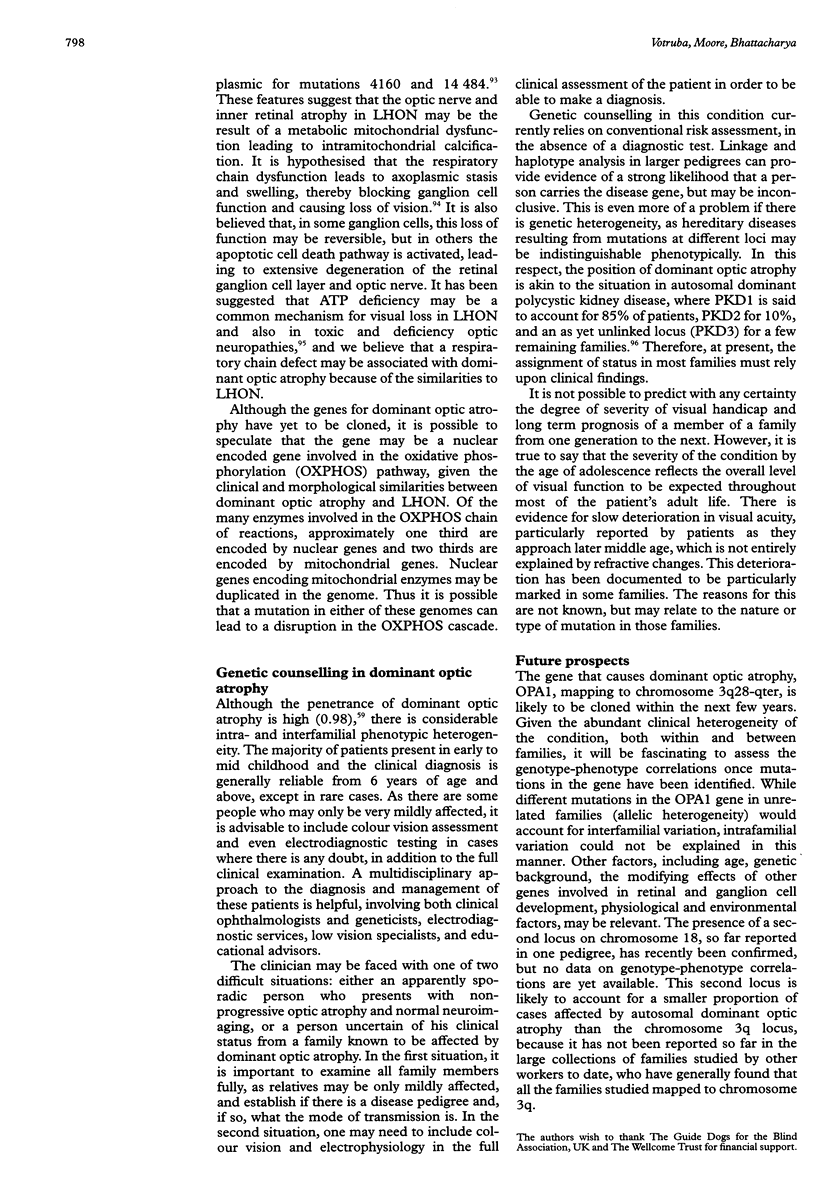
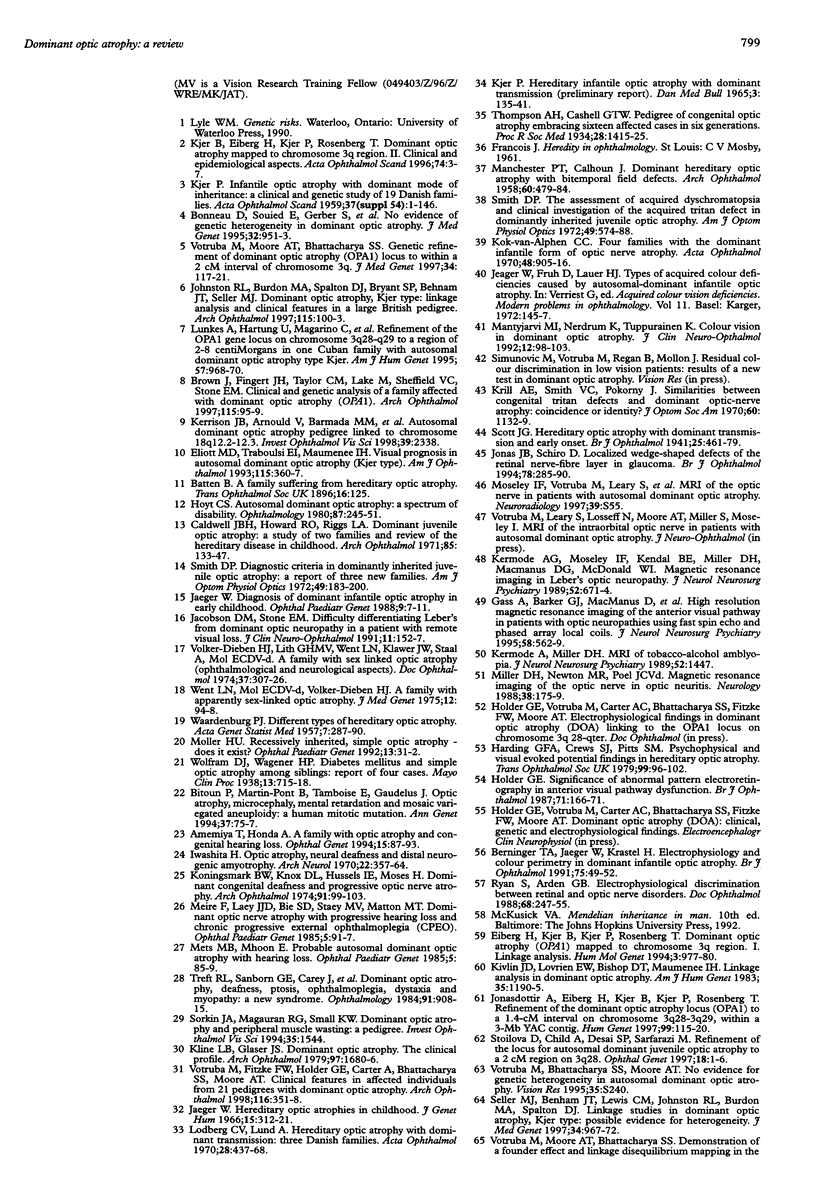
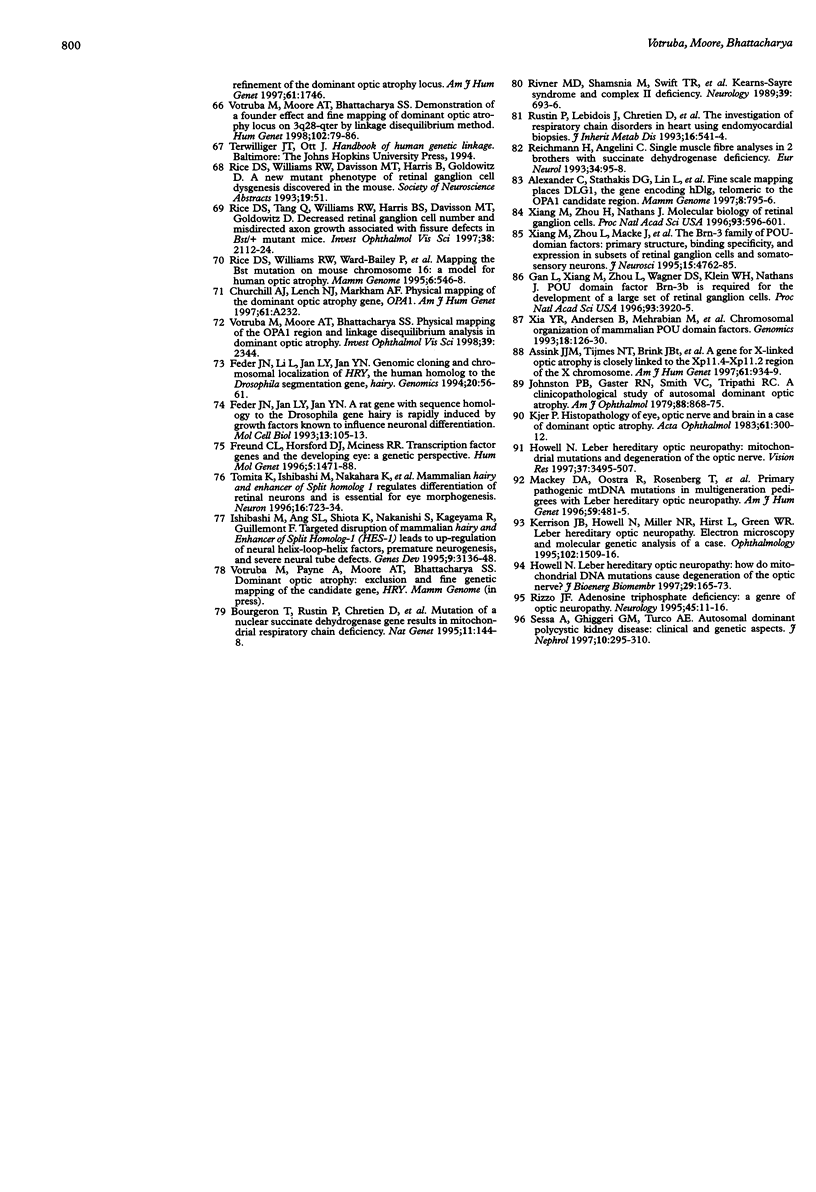
Images in this article
Selected References
These references are in PubMed. This may not be the complete list of references from this article.
- Alexander C., Stathakis D. G., Lin L., Rahman S., Bryant P. J., Auburger G., Chishti A. H. Fine scale mapping places DLG1, the gene encoding hDlg, telomeric to the OPA1 candidate region. Mamm Genome. 1997 Oct;8(10):795–796. doi: 10.1007/s003359900578. [DOI] [PubMed] [Google Scholar]
- Amemiya T., Honda A. A family with optic atrophy and congenital hearing loss. Ophthalmic Genet. 1994 Jun;15(2):87–93. doi: 10.3109/13816819409098868. [DOI] [PubMed] [Google Scholar]
- Assink J. J., Tijmes N. T., ten Brink J. B., Oostra R. J., Riemslag F. C., de Jong P. T., Bergen A. A. A gene for X-linked optic atrophy is closely linked to the Xp11.4-Xp11.2 region of the X chromosome. Am J Hum Genet. 1997 Oct;61(4):934–939. doi: 10.1086/514884. [DOI] [PMC free article] [PubMed] [Google Scholar]
- Bitoun P., Martin-Pont B., Tamboise E., Gaudelus J. Optic atrophy, microcephaly, mental retardation and mosaic variegated aneuploidy: a human mitotic mutation. Ann Genet. 1994;37(2):75–77. [PubMed] [Google Scholar]
- Bonneau D., Souied E., Gerber S., Rozet J. M., D'Haens E., Journel H., Plessis G., Weissenbach J., Munnich A., Kaplan J. No evidence of genetic heterogeneity in dominant optic atrophy. J Med Genet. 1995 Dec;32(12):951–953. doi: 10.1136/jmg.32.12.951. [DOI] [PMC free article] [PubMed] [Google Scholar]
- Bourgeron T., Rustin P., Chretien D., Birch-Machin M., Bourgeois M., Viegas-Péquignot E., Munnich A., Rötig A. Mutation of a nuclear succinate dehydrogenase gene results in mitochondrial respiratory chain deficiency. Nat Genet. 1995 Oct;11(2):144–149. doi: 10.1038/ng1095-144. [DOI] [PubMed] [Google Scholar]
- Brown J., Jr, Fingert J. H., Taylor C. M., Lake M., Sheffield V. C., Stone E. M. Clinical and genetic analysis of a family affected with dominant optic atrophy (OPA1) Arch Ophthalmol. 1997 Jan;115(1):95–99. doi: 10.1001/archopht.1997.01100150097016. [DOI] [PubMed] [Google Scholar]
- Caldwell J. B., Howard R. O., Riggs L. A. Dominant juvenile optic atrophy. A study in two families and review of hereditary disease in childhood. Arch Ophthalmol. 1971 Feb;85(2):133–147. doi: 10.1001/archopht.1971.00990050135004. [DOI] [PubMed] [Google Scholar]
- Eiberg H., Kjer B., Kjer P., Rosenberg T. Dominant optic atrophy (OPA1) mapped to chromosome 3q region. I. Linkage analysis. Hum Mol Genet. 1994 Jun;3(6):977–980. doi: 10.1093/hmg/3.6.977. [DOI] [PubMed] [Google Scholar]
- Eliott D., Traboulsi E. I., Maumenee I. H. Visual prognosis in autosomal dominant optic atrophy (Kjer type). Am J Ophthalmol. 1993 Mar 15;115(3):360–367. doi: 10.1016/s0002-9394(14)73589-5. [DOI] [PubMed] [Google Scholar]
- Feder J. N., Jan L. Y., Jan Y. N. A rat gene with sequence homology to the Drosophila gene hairy is rapidly induced by growth factors known to influence neuronal differentiation. Mol Cell Biol. 1993 Jan;13(1):105–113. doi: 10.1128/mcb.13.1.105. [DOI] [PMC free article] [PubMed] [Google Scholar]
- Feder J. N., Li L., Jan L. Y., Jan Y. N. Genomic cloning and chromosomal localization of HRY, the human homolog to the Drosophila segmentation gene, hairy. Genomics. 1994 Mar 1;20(1):56–61. doi: 10.1006/geno.1994.1126. [DOI] [PubMed] [Google Scholar]
- Freund C., Horsford D. J., McInnes R. R. Transcription factor genes and the developing eye: a genetic perspective. Hum Mol Genet. 1996;5(Spec No):1471–1488. doi: 10.1093/hmg/5.supplement_1.1471. [DOI] [PubMed] [Google Scholar]
- Gan L., Xiang M., Zhou L., Wagner D. S., Klein W. H., Nathans J. POU domain factor Brn-3b is required for the development of a large set of retinal ganglion cells. Proc Natl Acad Sci U S A. 1996 Apr 30;93(9):3920–3925. doi: 10.1073/pnas.93.9.3920. [DOI] [PMC free article] [PubMed] [Google Scholar]
- Gass A., Barker G. J., MacManus D., Sanders M., Riordan-Eva P., Tofts P. S., Thorpe J., McDonald W. I., Moseley I. F., Miller D. H. High resolution magnetic resonance imaging of the anterior visual pathway in patients with optic neuropathies using fast spin echo and phased array local coils. J Neurol Neurosurg Psychiatry. 1995 May;58(5):562–569. doi: 10.1136/jnnp.58.5.562. [DOI] [PMC free article] [PubMed] [Google Scholar]
- Harding G. F., Crews S. J., Pitts S. M. Psychophysical and visual evoked potential findings in hereditary optic atrophy. Trans Ophthalmol Soc U K. 1979 Apr;99(1):96–102. [PubMed] [Google Scholar]
- Holder G. E. Significance of abnormal pattern electroretinography in anterior visual pathway dysfunction. Br J Ophthalmol. 1987 Mar;71(3):166–171. doi: 10.1136/bjo.71.3.166. [DOI] [PMC free article] [PubMed] [Google Scholar]
- Howell N. Leber hereditary optic neuropathy: how do mitochondrial DNA mutations cause degeneration of the optic nerve? J Bioenerg Biomembr. 1997 Apr;29(2):165–173. doi: 10.1023/a:1022690030664. [DOI] [PubMed] [Google Scholar]
- Howell N. Leber hereditary optic neuropathy: mitochondrial mutations and degeneration of the optic nerve. Vision Res. 1997 Dec;37(24):3495–3507. doi: 10.1016/S0042-6989(96)00167-8. [DOI] [PubMed] [Google Scholar]
- Hoyt C. S. Autosomal dominant optic atrophy. A spectrum of disability. Ophthalmology. 1980 Mar;87(3):245–251. doi: 10.1016/s0161-6420(80)35247-0. [DOI] [PubMed] [Google Scholar]
- Ishibashi M., Ang S. L., Shiota K., Nakanishi S., Kageyama R., Guillemot F. Targeted disruption of mammalian hairy and Enhancer of split homolog-1 (HES-1) leads to up-regulation of neural helix-loop-helix factors, premature neurogenesis, and severe neural tube defects. Genes Dev. 1995 Dec 15;9(24):3136–3148. doi: 10.1101/gad.9.24.3136. [DOI] [PubMed] [Google Scholar]
- Iwashita H., Inoue N., Araki S., Kuroiwa Y. Optic atrophy, neural deafness, and distal neurogenic amyotrophy; report of a family with two affected siblings. Arch Neurol. 1970 Apr;22(4):357–364. doi: 10.1001/archneur.1970.00480220071010. [DOI] [PubMed] [Google Scholar]
- Jacobson D. M., Stone E. M. Difficulty differentiating Leber's from dominant optic neuropathy in a patient with remote visual loss. J Clin Neuroophthalmol. 1991 Sep;11(3):152–157. [PubMed] [Google Scholar]
- Jaeger W. Diagnosis of dominant infantile optic atrophy in early childhood. Ophthalmic Paediatr Genet. 1988 Mar;9(1):7–11. doi: 10.3109/13816818809031474. [DOI] [PubMed] [Google Scholar]
- Jaeger W., Früh D., Lauer H. J. Types of acquired colour deficiencies caused by autosomal-dominant infantile optic atrophy. Mod Probl Ophthalmol. 1972;11:145–147. [PubMed] [Google Scholar]
- Jaeger W. Hereditary optic atrophies in childhood. J Genet Hum. 1966 Dec;15(3):312–321. [PubMed] [Google Scholar]
- Johnston P. B., Gaster R. N., Smith V. C., Tripathi R. C. A clinicopathologic study of autosomal dominant optic atrophy. Am J Ophthalmol. 1979 Nov;88(5):868–875. doi: 10.1016/0002-9394(79)90565-8. [DOI] [PubMed] [Google Scholar]
- Johnston R. L., Burdon M. A., Spalton D. J., Bryant S. P., Behnam J. T., Seller M. J. Dominant optic atrophy, Kjer type. Linkage analysis and clinical features in a large British pedigree. Arch Ophthalmol. 1997 Jan;115(1):100–103. doi: 10.1001/archopht.1997.01100150102017. [DOI] [PubMed] [Google Scholar]
- Jonas J. B., Schiro D. Localised wedge shaped defects of the retinal nerve fibre layer in glaucoma. Br J Ophthalmol. 1994 Apr;78(4):285–290. doi: 10.1136/bjo.78.4.285. [DOI] [PMC free article] [PubMed] [Google Scholar]
- Jonasdottir A., Eiberg H., Kjer B., Kjer P., Rosenberg T. Refinement of the dominant optic atrophy locus (OPA1) to a 1.4-cM interval on chromosome 3q28-3q29, within a 3-Mb YAC contig. Hum Genet. 1997 Jan;99(1):115–120. doi: 10.1007/s004390050323. [DOI] [PubMed] [Google Scholar]
- KJER P. Hereditary infantile optic atrophy with dominant transmission; preliminary report. Dan Med Bull. 1956 Aug;3(5):135–141. [PubMed] [Google Scholar]
- KJER P. Infantile optic atrophy with dominant mode of inheritance: a clinical and genetic study of 19 Danish families. Acta Ophthalmol Suppl. 1959;164(Suppl 54):1–147. [PubMed] [Google Scholar]
- Kantorow M., Kays T., Horwitz J., Huang Q., Sun J., Piatigorsky J., Carper D. Differential display detects altered gene expression between cataractous and normal human lenses. Invest Ophthalmol Vis Sci. 1998 Nov;39(12):2344–2354. [PubMed] [Google Scholar]
- Kermode A. G., Moseley I. F., Kendall B. E., Miller D. H., MacManus D. G., McDonald W. I. Magnetic resonance imaging in Leber's optic neuropathy. J Neurol Neurosurg Psychiatry. 1989 May;52(5):671–674. doi: 10.1136/jnnp.52.5.671. [DOI] [PMC free article] [PubMed] [Google Scholar]
- Kermode A. G., Plant G. T., Miller D. H., Kendall B. E., McDonald W. I. Tobacco-alcohol amblyopia: magnetic resonance imaging findings. J Neurol Neurosurg Psychiatry. 1989 Dec;52(12):1447–1447. doi: 10.1136/jnnp.52.12.1447. [DOI] [PMC free article] [PubMed] [Google Scholar]
- Kerrison J. B., Howell N., Miller N. R., Hirst L., Green W. R. Leber hereditary optic neuropathy. Electron microscopy and molecular genetic analysis of a case. Ophthalmology. 1995 Oct;102(10):1509–1516. doi: 10.1016/s0161-6420(95)30838-x. [DOI] [PubMed] [Google Scholar]
- Kivlin J. D., Lovrien E. W., Bishop D. T., Maumenee I. H. Linkage analysis in dominant optic atrophy. Am J Hum Genet. 1983 Nov;35(6):1190–1195. [PMC free article] [PubMed] [Google Scholar]
- Kjer B., Eiberg H., Kjer P., Rosenberg T. Dominant optic atrophy mapped to chromosome 3q region. II. Clinical and epidemiological aspects. Acta Ophthalmol Scand. 1996 Feb;74(1):3–7. doi: 10.1111/j.1600-0420.1996.tb00672.x. [DOI] [PubMed] [Google Scholar]
- Kjer P., Jensen O. A., Klinken L. Histopathology of eye, optic nerve and brain in a case of dominant optic atrophy. Acta Ophthalmol (Copenh) 1983 Apr;61(2):300–312. doi: 10.1111/j.1755-3768.1983.tb01424.x. [DOI] [PubMed] [Google Scholar]
- Kline L. B., Glaser J. S. Dominant optic atrophy. The clinical profile. Arch Ophthalmol. 1979 Sep;97(9):1680–1686. doi: 10.1001/archopht.1979.01020020248013. [DOI] [PubMed] [Google Scholar]
- Kok-van Alphen C. C. Four families with the dominant infantile form of optic nerve atrophy. Acta Ophthalmol (Copenh) 1970;48(5):905–916. doi: 10.1111/j.1755-3768.1970.tb08211.x. [DOI] [PubMed] [Google Scholar]
- Konigsmark B. W., Knox D. L., Hussels I. E., Moses H. Dominant congenital deafness and progressive optic nerve atrophy. Occurrence in four generations of a family. Arch Ophthalmol. 1974 Feb;91(2):99–103. doi: 10.1001/archopht.1974.03900060105003. [DOI] [PubMed] [Google Scholar]
- LODBERG C. V., LUND A. Hereditary optic atrophy with dominant transmission; three Danish families. Acta Ophthalmol (Copenh) 1950;28(4):437–468. doi: 10.1111/j.1755-3768.1950.tb00001.x. [DOI] [PubMed] [Google Scholar]
- Lunkes A., Hartung U., Magariño C., Rodríguez M., Palmero A., Rodríguez L., Heredero L., Weissenbach J., Weber J., Auburger G. Refinement of the OPA1 gene locus on chromosome 3q28-q29 to a region of 2-8 cM, in one Cuban pedigree with autosomal dominant optic atrophy type Kjer. Am J Hum Genet. 1995 Oct;57(4):968–970. [PMC free article] [PubMed] [Google Scholar]
- MANCHESTER P. T., Jr, CALHOUN F. P., Jr Dominant hereditary optic atrophy with bitemporal field defects. AMA Arch Ophthalmol. 1958 Sep;60(3):479–484. doi: 10.1001/archopht.1958.00940080497021. [DOI] [PubMed] [Google Scholar]
- Mackey D. A., Oostra R. J., Rosenberg T., Nikoskelainen E., Bronte-Stewart J., Poulton J., Harding A. E., Govan G., Bolhuis P. A., Norby S. Primary pathogenic mtDNA mutations in multigeneration pedigrees with Leber hereditary optic neuropathy. Am J Hum Genet. 1996 Aug;59(2):481–485. [PMC free article] [PubMed] [Google Scholar]
- Meire F., De Laey J. J., de Bie S., van Staey M., Matton M. T. Dominant optic nerve atrophy with progressive hearing loss and chronic progressive external ophthalmoplegia (CPEO). Ophthalmic Paediatr Genet. 1985 Feb;5(1-2):91–97. doi: 10.3109/13816818509007861. [DOI] [PubMed] [Google Scholar]
- Mets M. B., Mhoon E. Probable autosomal dominant optic atrophy with hearing loss. Ophthalmic Paediatr Genet. 1985 Feb;5(1-2):85–89. doi: 10.3109/13816818509007860. [DOI] [PubMed] [Google Scholar]
- Miller D. H., Newton M. R., van der Poel J. C., du Boulay E. P., Halliday A. M., Kendall B. E., Johnson G., MacManus D. G., Moseley I. F., McDonald W. I. Magnetic resonance imaging of the optic nerve in optic neuritis. Neurology. 1988 Feb;38(2):175–179. doi: 10.1212/wnl.38.2.175. [DOI] [PubMed] [Google Scholar]
- Mäntyjärvi M. I., Nerdrum K., Tuppurainen K. Color vision in dominant optic atrophy. J Clin Neuroophthalmol. 1992 Jun;12(2):98–103. [PubMed] [Google Scholar]
- Møller H. U. Recessively inherited, simple optic atrophy--does it exist? Ophthalmic Paediatr Genet. 1992 Mar;13(1):31–32. doi: 10.3109/13816819209070051. [DOI] [PubMed] [Google Scholar]
- Reichmann H., Angelini C. Single muscle fibre analyses in 2 brothers with succinate dehydrogenase deficiency. Eur Neurol. 1994;34(2):95–98. doi: 10.1159/000117016. [DOI] [PubMed] [Google Scholar]
- Rice D. S., Tang Q., Williams R. W., Harris B. S., Davisson M. T., Goldowitz D. Decreased retinal ganglion cell number and misdirected axon growth associated with fissure defects in Bst/+ mutant mice. Invest Ophthalmol Vis Sci. 1997 Sep;38(10):2112–2124. [PubMed] [Google Scholar]
- Rice D. S., Williams R. W., Ward-Bailey P., Johnson K. R., Harris B. S., Davisson M. T., Goldowitz D. Mapping the Bst mutation on mouse chromosome 16: a model for human optic atrophy. Mamm Genome. 1995 Aug;6(8):546–548. doi: 10.1007/BF00356174. [DOI] [PubMed] [Google Scholar]
- Rivner M. H., Shamsnia M., Swift T. R., Trefz J., Roesel R. A., Carter A. L., Yanamura W., Hommes F. A. Kearns-Sayre syndrome and complex II deficiency. Neurology. 1989 May;39(5):693–696. doi: 10.1212/wnl.39.5.693. [DOI] [PubMed] [Google Scholar]
- Rizzo J. F., 3rd Adenosine triphosphate deficiency: a genre of optic neuropathy. Neurology. 1995 Jan;45(1):11–16. doi: 10.1212/wnl.45.1.11. [DOI] [PubMed] [Google Scholar]
- Rustin P., Lebidois J., Chretien D., Bourgeron T., Piechaud J. F., Rötig A., Sidi D., Munnich A. The investigation of respiratory chain disorders in heart using endomyocardial biopsies. J Inherit Metab Dis. 1993;16(3):541–544. doi: 10.1007/BF00711676. [DOI] [PubMed] [Google Scholar]
- Ryan S., Arden G. B. Electrophysiological discrimination between retinal and optic nerve disorders. Doc Ophthalmol. 1988 Mar-Apr;68(3-4):247–255. doi: 10.1007/BF00156431. [DOI] [PubMed] [Google Scholar]
- Scott J. G. HEREDITARY OPTIC ATROPHY WITH DOMINANT TRANSMISSION AND EARLY ONSET. Br J Ophthalmol. 1941 Oct;25(10):461–479. doi: 10.1136/bjo.25.10.461. [DOI] [PMC free article] [PubMed] [Google Scholar]
- Seller M. J., Behnam J. T., Lewis C. M., Johnston R. L., Burdon M. A., Spalton D. J. Linkage studies in dominant optic atrophy, Kjer type: possible evidence for heterogeneity. J Med Genet. 1997 Dec;34(12):967–972. doi: 10.1136/jmg.34.12.967. [DOI] [PMC free article] [PubMed] [Google Scholar]
- Sessa A., Ghiggeri G. M., Turco A. E. Autosomal dominant polycystic kidney disease: clinical and genetic aspects. J Nephrol. 1997 Nov-Dec;10(6):295–310. [PubMed] [Google Scholar]
- Smith D. P. Diagnostic criteria in cominantly inherited juvenile optic atrophy. A report of three new families. Am J Optom Arch Am Acad Optom. 1972 Mar;49(3):183–200. doi: 10.1097/00006324-197203000-00001. [DOI] [PubMed] [Google Scholar]
- Smith D. P. The assessment of acquired dyschromatopsia and clinical investigation of the acquired tritan defect in dominantly inherited juvenile atrophy. Am J Optom Arch Am Acad Optom. 1972 Jul;49(7):574–588. doi: 10.1097/00006324-197207000-00006. [DOI] [PubMed] [Google Scholar]
- Stoilova D., Child A., Desai S. P., Sarfarazi M. Refinement of the locus for autosomal dominant juvenile optic atrophy to a 2 cM region on 3q28. Ophthalmic Genet. 1997 Mar;18(1):1–6. doi: 10.3109/13816819709057877. [DOI] [PubMed] [Google Scholar]
- Thompson A. H., Cashell G. T. A Pedigree of Congenital Optic Atrophy Embracing Sixteen Affected Cases In Six Generations: (Section of Ophthalmology). Proc R Soc Med. 1935 Aug;28(10):1415–1425. doi: 10.1177/003591573502801036. [DOI] [PMC free article] [PubMed] [Google Scholar]
- Tomita K., Ishibashi M., Nakahara K., Ang S. L., Nakanishi S., Guillemot F., Kageyama R. Mammalian hairy and Enhancer of split homolog 1 regulates differentiation of retinal neurons and is essential for eye morphogenesis. Neuron. 1996 Apr;16(4):723–734. doi: 10.1016/s0896-6273(00)80093-8. [DOI] [PubMed] [Google Scholar]
- Treft R. L., Sanborn G. E., Carey J., Swartz M., Crisp D., Wester D. C., Creel D. Dominant optic atrophy, deafness, ptosis, ophthalmoplegia, dystaxia, and myopathy. A new syndrome. Ophthalmology. 1984 Aug;91(8):908–915. doi: 10.1016/s0161-6420(84)34214-2. [DOI] [PubMed] [Google Scholar]
- Votruba M., Fitzke F. W., Holder G. E., Carter A., Bhattacharya S. S., Moore A. T. Clinical features in affected individuals from 21 pedigrees with dominant optic atrophy. Arch Ophthalmol. 1998 Mar;116(3):351–358. doi: 10.1001/archopht.116.3.351. [DOI] [PubMed] [Google Scholar]
- Votruba M., Moore A. T., Bhattacharya S. S. Demonstration of a founder effect and fine mapping of dominant optic atrophy locus on 3q28-qter by linkage disequilibrium method: a study of 38 British Isles pedigrees. Hum Genet. 1998 Jan;102(1):79–86. doi: 10.1007/s004390050657. [DOI] [PubMed] [Google Scholar]
- Votruba M., Moore A. T., Bhattacharya S. S. Genetic refinement of dominant optic atrophy (OPA1) locus to within a 2 cM interval of chromosome 3q. J Med Genet. 1997 Feb;34(2):117–121. doi: 10.1136/jmg.34.2.117. [DOI] [PMC free article] [PubMed] [Google Scholar]
- WAARDENBURG P. J. Different types of hereditary optic atrophy. Acta Genet Stat Med. 1957;7(2):287–290. doi: 10.1159/000150987. [DOI] [PubMed] [Google Scholar]
- Xia Y. R., Andersen B., Mehrabian M., Diep A. T., Warden C. H., Mohandas T., McEvilly R. J., Rosenfeld M. G., Lusis A. J. Chromosomal organization of mammalian POU domain factors. Genomics. 1993 Oct;18(1):126–130. doi: 10.1006/geno.1993.1435. [DOI] [PubMed] [Google Scholar]
- Xiang M., Zhou H., Nathans J. Molecular biology of retinal ganglion cells. Proc Natl Acad Sci U S A. 1996 Jan 23;93(2):596–601. doi: 10.1073/pnas.93.2.596. [DOI] [PMC free article] [PubMed] [Google Scholar]
- Xiang M., Zhou L., Macke J. P., Yoshioka T., Hendry S. H., Eddy R. L., Shows T. B., Nathans J. The Brn-3 family of POU-domain factors: primary structure, binding specificity, and expression in subsets of retinal ganglion cells and somatosensory neurons. J Neurosci. 1995 Jul;15(7 Pt 1):4762–4785. doi: 10.1523/JNEUROSCI.15-07-04762.1995. [DOI] [PMC free article] [PubMed] [Google Scholar]



